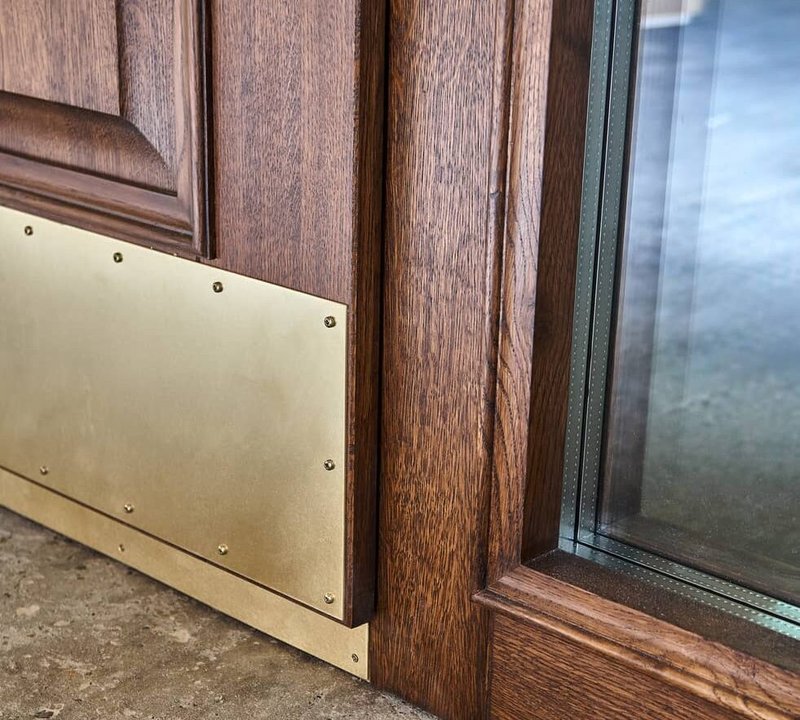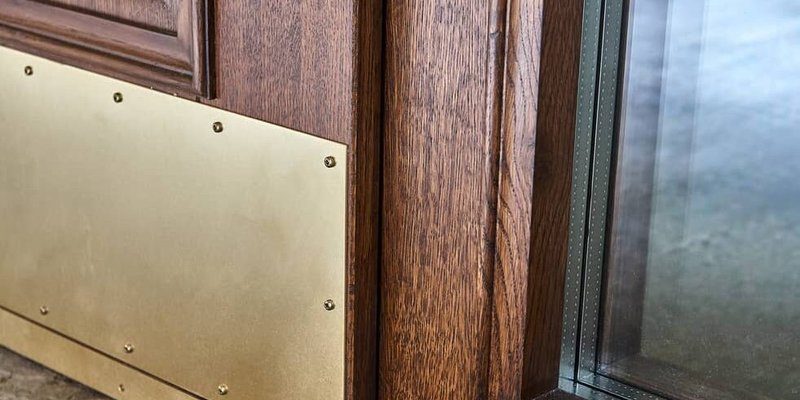
Pitted kick plates are kind of like those old trophies you find in your parents’ attic: they once gleamed, but now they’re covered in the evidence of time and use. The difference is, you probably *want* your door to look sharp for guests and not like it just survived a hailstorm. The good news? With a little patience and some practical steps, you can repair a pitted kick plate and give your entryway a facelift without having to replace the whole thing.
So, whether you have a Baldwin, Schlage, or even a no-name brass or stainless steel plate, these repair steps will help you tackle the pitting and restore what’s under all that wear and tear.
Why Do Kick Plates Pit and Weather?
Kick plates aren’t just for show—they take a beating every single day. Think about it: these metal plates sit right at the bottom of your door, catching every scuff, boot, and splash that comes their way. But it’s not just foot traffic you have to worry about. The real villains are the elements—especially moisture and road salt.
Here’s the thing: *pitting* happens when water, salt, and chemicals settle on the surface and slowly eat into the metal. Brass plates often tarnish and develop little craters, while stainless steel can get rough and even start to rust if it’s not high-quality. Aluminum gets those tiny corrosion spots that make the whole thing look tired. Over time, even the best protective coatings wear down, and those little pits start to show up.
You might be wondering, “Does brand matter?” Honestly, while big names like Baldwin and Schlage use better materials and coatings, no plate is totally immune. If your entryway faces the brunt of storms or you live near the ocean (that salty air!), you’re likely to see pitting sooner or later. That’s just the nature of metal and weather.
How To Tell If Your Kick Plate Is Fixable
Before you break out the sandpaper, it’s smart to figure out just how bad your kick plate’s pitting really is. Light, shallow pitting is pretty common and usually means the damage is mostly at the surface. Deep pits or heavy rust, on the other hand, might mean replacement is the better bet.
Here’s how to check:
- Light surface pits: Run your fingers over the plate. If you feel some roughness but the metal isn’t Swiss cheese, you’re in good shape for a DIY repair.
- Deep pitting or holes: If you see actual holes or very deep craters, the plate has lost a lot of material. At this point, patching won’t really hold, and it might be time for a new plate.
- Severe rusting: Rust can sometimes be sanded off, but if the corrosion is deep or covers most of the surface, it’s often safer to replace it (especially with thin aluminum).
Still unsure? Try cleaning a small spot with a gentle abrasive like a baking soda paste. If it polishes up and the pits aren’t too noticeable, you’re good to go. If the plate still looks rough or “moth-eaten,” replacement might be your best option. Don’t worry, though—most pitted kick plates can be fixed up with some care and elbow grease.
Gathering the Right Tools and Materials
Tackling a pitted kick plate repair doesn’t require a full hardware store, but having the right supplies makes the job easier—and the results better. Here’s what you’ll need, whether you’re dealing with a Baldwin brass or a basic stainless steel plate:
- Mild cleaner (dish soap or vinegar solution)
- Non-scratch scrub pads or soft cloths
- Assorted sandpaper (start with 400-grit, finish with 800 or 1000 for smoother finishes)
- Brass or metal polish (like Brasso or Flitz for brand-name plates)
- Protective gloves and eye protection
- Microfiber towels for wiping and buffing
- Painters’ tape (to protect the door around the plate)
- Clear metal lacquer or polyurethane spray (optional, for sealing and longer-lasting results)
Depending on the plate, you might also need a screwdriver to remove it from the door. If you’re not sure what your plate is made of, check for markings or try a magnet (magnets stick to steel, don’t to brass or aluminum). Getting the right supplies up front keeps you from having to run to the store mid-project and lets you focus on getting that smooth, like-new finish.
Step-by-Step: Repairing Your Pitted Kick Plate
Let’s get into the actual repair. This process works for most weather-exposed kick plates—brass, stainless steel, or aluminum.
1. Remove the Kick Plate (Optional but Recommended)
If possible, unscrew the plate from the door. This makes cleaning, sanding, and polishing way easier (and you won’t risk scratching your door). If it’s stuck or you don’t want to fuss with screws, cover the door edges with painters’ tape to avoid damage.
2. Clean Off Dirt and Grime
Mix a little dish soap with water, then use a soft cloth or sponge to scrub off all surface dirt. Pitted spots will hold grime, so take your time and get everything as clean as possible. Rinse and dry thoroughly. Sometimes you’ll be surprised by how much brighter the plate looks just after a wash.
3. Lightly Sand the Pitted Areas
Here’s the important part: gently sand the pitted spots, starting with the lowest grit sandpaper (around 400). *Don’t* press too hard—you want to smooth out the craters without digging deeper pits. Move in a circular motion or follow the wood grain if you can see it. Wipe away dust as you go.
Move up to a higher grit (800 or even 1000) to polish further. For brass, use less pressure; for stainless steel, you can be a bit firmer. The goal is to smooth out rough spots so they blend with the rest of the plate.
4. Polish and Buff
Now comes the shine. Apply a dab of metal polish and use a soft cloth to work it into the surface using small, circular motions. For deep pits, you might need to repeat this step a few times. Wipe away any residue, then buff with a clean microfiber towel. You’ll start to see the difference—pits will fade, and the whole plate will look a lot brighter.
5. Optional: Apply a Protective Finish
If you want to go the extra mile, spray on a clear lacquer or metal polyurethane. This step seals the refinished plate and helps slow down future pitting. Let it dry completely before reinstalling. Most brand-name plates, like Baldwin or Schlage, come with a finish from the factory, so this step helps preserve your work.
Tips for Maintaining Your Kick Plate After Repair
Now that your kick plate looks refreshed, regular care will keep it from pitting again—at least, for a while. Here’s how to stretch out the results:
- Wipe down the plate every few weeks—especially after rain or snow. Salt and moisture are pitting’s best friends.
- Reapply polish every couple of months for brass plates. Stainless steel plates don’t need it as often but benefit from a quick buff now and then.
- Avoid harsh cleaners and abrasive scrubs unless you’re planning another round of sanding.
- Touch up scratches or chips in the finish with clear lacquer to keep water and salt out.
Let me explain—sometimes it’s easy to forget the little stuff. But honestly, when you set a reminder to clean and polish your kick plate, you’ll be surprised at how long that “just restored” look lasts.
When to Replace Instead of Repair
There are times when even the best DIY fix isn’t enough. If your kick plate is so pitted or corroded that sanding leaves sharp edges, or if holes have started to form, it’s probably time for a replacement. This is especially true for thin aluminum plates that bend easily or steel plates that have rusted through.
Replacement isn’t as intimidating—or expensive—as it sounds. Most hardware stores have a variety of sizes, metals, and finishes. Swapping in a new plate is usually a quick job, and you might be able to upgrade to a more durable finish or try a different look. If you loved the old brand (like Baldwin), many companies sell direct replacements.
A comparison: repairing is like patching a favorite pair of jeans—worth it if the fabric’s still strong. But if your kick plate is more hole than metal, a fresh start will save you work in the long run.
Choosing the Right Finish and Material For Your Next Kick Plate
If you decide to replace your kick plate, or just want to avoid future pitting, choosing the right material and finish makes a difference. Here’s what to consider:
- Brass: Classic look, but needs regular polishing. Lacquered brass resists tarnish longer but will eventually need attention.
- Stainless Steel: Modern, low-maintenance, and highly resistant to weather. Good for harsh climates or heavy use. Brushed finishes hide scratches better than polished ones.
- Aluminum: Lightweight and cheap, but pits easily. Look for anodized aluminum for better weather resistance.
- Powder-coated or painted finishes: These add a layer of protection but can chip and peel if scratched. Good for matching unusual door colors.
Comparing brands? Baldwin and Schlage tend to use heavier metals and thicker coatings, which stand up better in the long run. For most people, stainless steel is the “set it and forget it” option—especially if you live where snow and salt are common guests at your doorstep.
Living With a Repaired Kick Plate: What to Expect
After you’ve sanded, polished, and sealed your weather-beaten kick plate, you’ll notice the improvement every time you walk up to your door. The reflection won’t be perfect (unless you’re a pro with a buffing wheel), but the plate will look cleaner, shinier, and far less “worn out.” You might even get a little satisfaction every time you spot your repair holding strong after a thunderstorm or mud splash.
Here’s the thing: every kick plate tells the story of your home. A bit of patina is normal—and some folks actually like a weathered look. But regular care stops those tiny pits from becoming big eyesores. Like tuning up a car or sharpening kitchen knives, a little attention goes a long way toward keeping things functional and good-looking.
“A shiny kick plate isn’t just about curb appeal—it’s about taking pride in the details that welcome you (and everyone else) home.”
So whether you’re patching up a Baldwin brass plate or smoothing out a generic steel one, don’t stress if things aren’t factory-perfect. You’ve tackled the pits, polished out years of weather, and learned how to keep it gleaming. That’s honestly more satisfying than buying something new.
Stay ahead of the elements, keep your plate polished, and your entryway will keep making a great first impression.
